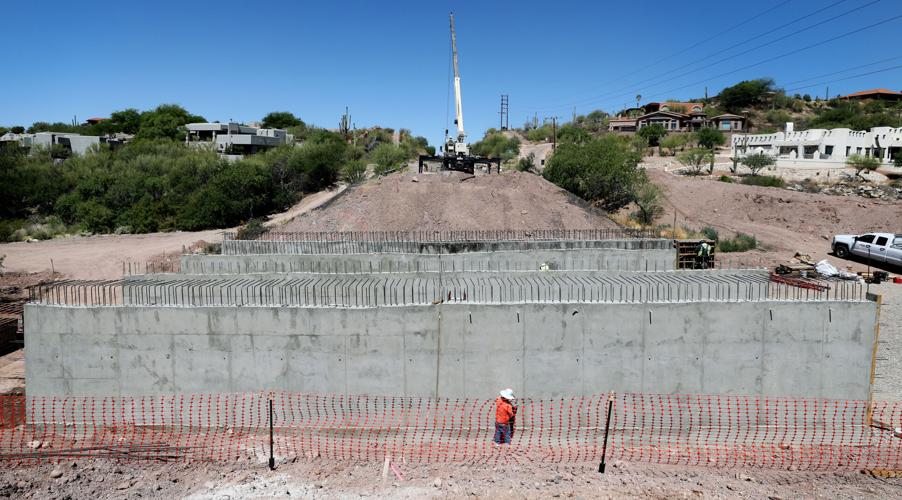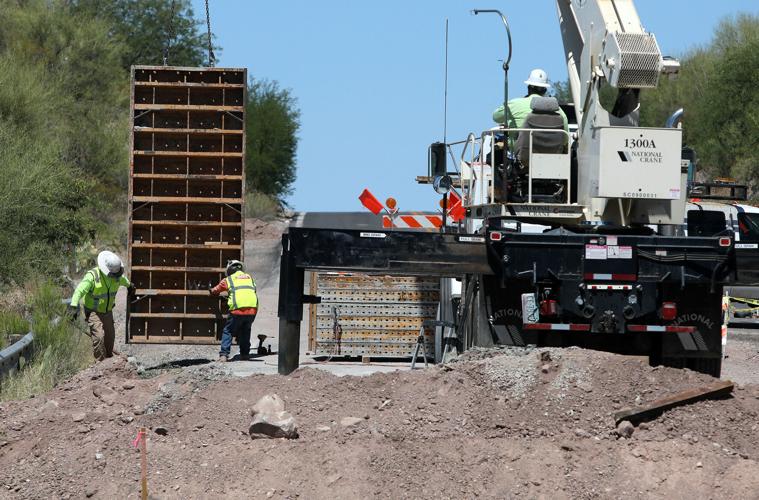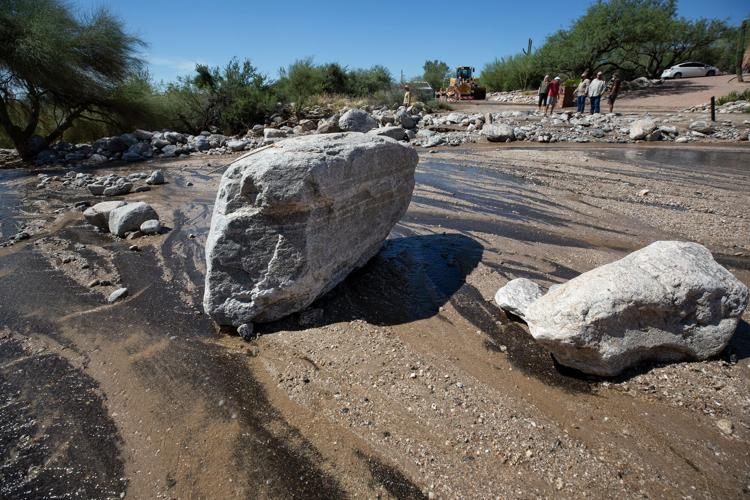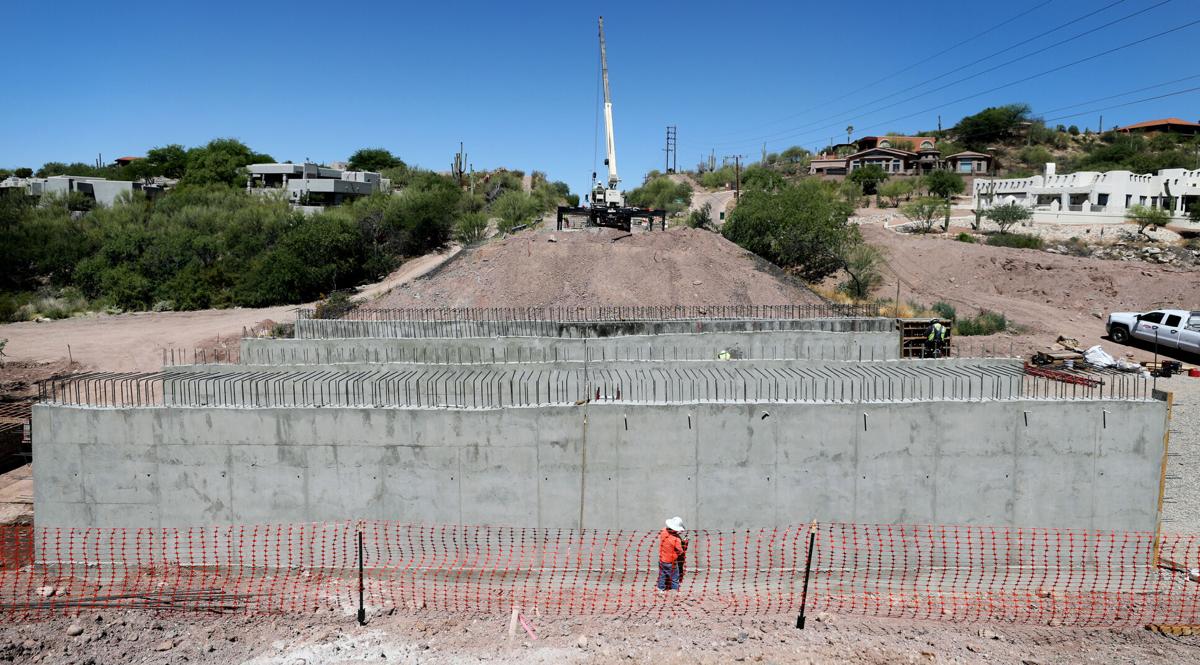Along with its usual preparations for monsoon season, the Pima County Regional Flood Control District spent the past year snapping up pricey real estate along a flood-prone street in the Catalina Foothills.
The district has closed on four properties so far northwest of Swan Road and Skyline Drive, with a fifth purchase slated for approval by the Pima County Board of Supervisors within the next month or two.
County taxpayers will end up shelling out about $3.7 million for the five houses, an average of $740,000 each. That does not include the added cost of knocking the structures down and cleaning up the properties to make sure they don’t cause any additional flooding problems elsewhere in the neighborhood built in and around Finger Rock Wash.
“This was an opportunity to remove people from harm’s way,” said Brian Jones, the flood district’s deputy director and floodplain administrator.
By buying and demolishing the houses, he said, “We’re letting the floodplain be what it was meant to be: open space.”
Elsewhere, the flood district is finishing up some more traditional work ahead of monsoon 2023, which officially begins June 15.
“I think we’re well prepared and ready for this year,” said Colby Fryar, manager of the district’s Infrastructure Management Division.
He said this off-season has been spent on a number of smaller projects, including flood improvements on four washes in Green Valley, bank protection on a wash that runs through a neighborhood in Sahuarita, and construction of a new water-harvesting basin on the east side of Tucson.
In recent days, workers could be seen using heavy equipment to remove sediment and reshape the banks along the Cañada del Oro wash between Overton Road and the North La Cholla Boulevard bridge. Fryar said flooding last year along that stretch of the wash had begun to cut in the direction of the Chuck Huckelberry Loop, putting the popular walking and bicycling path at risk.
Crews have also been out scooping built-up sediment and mowing excess trees and shrubs from other flood channels throughout the county to keep them clear ahead of the region’s seasonal downpours.
“It increases the flow capacity of a channel, so it can carry more water,” Fryar said of such routine maintenance work.

Contractors for the Pima County Regional Flood Control District continue their work on building a new box culvert to carry floodwater in the Finger Rock Wash beneath Skyline Drive at Columbus Boulevard in Tucson on May 31.
Too many plants can dam up channels or get washed downstream to collect dangerously beneath road bridges.
But keeping washes clear is a balancing act, Fryar said, because the trees and bushes that grow there also provide shade and important habitat for wildlife.
“We don’t just go out and clear-cut it. We’re very specific about what we take out,” he said.
Buying up danger
There was no flood district and no county regulations about building in flood zones when the Coronado Foothills Estates subdivision was first mapped out in the early 1960s.
As a result, Jones said, some 56 homes were allowed to be built within the floodplain of Finger Rock Wash.
A Pima County Flood Control District camera caught the July 31 flood on Finger Rock Wash.
Two major flash floods have swept down the wash since the Bighorn Fire scorched the Catalina Mountains above the drainage in 2020. Long-time residents of the neighborhood say they have never seen the wash run with such intensity.
But as bad as the most recent torrents were, neither of them approached the level of a 100-year flood, a term hydrologists and statisticians use for a rainfall event with a one-in-100 chance of happening in any given year.
During a downpour like that, Jones said, there will be “dozens more houses surrounded by floodwaters” in the subdivision north of Skyline Drive.
The district is purchasing the five homes in Coronado Foothills Estates with funds from its Flood-prone Land Acquisition Program, or FLAP, which was created after the devastating floods of 1983 to proactively buy imperiled property.
FLAP only buys from owners who are willing to sell and only has about $1 million a year available to purchase property for its appraised value, so to make up the difference this time, the district and the county delayed other, lower priority projects and diverted funds from other accounts, Jones said.
All five houses are located along a quarter-mile stretch of Havasu Road, which runs parallel to the wash and also tends to flood. “Water is coming in their front doors off of Havasu at the same time it’s coming in their back doors from Finger Rock Wash,” Jones said.

Boulders and debris blocked Havasu Road at Columbus Boulevard on Aug. 1, 2022, after a raging flash flood on Finger Rock Wash that swamped a handful of homes in the Catalina Foothills.
One of the homes was operating as an assisted living facility until July 31, when 10 residents had to be rescued by firefighters during a flash flood that filled the building with several feet of water.
Jones said all five homes will be demolished at the same time later this year, after monsoon season is over, to make sure the work is done in a coordinated way that will not alter the flow of the wash and “make things worse for property owners downstream.”
Since last year’s flood, nine homeowners, including the owners of the assisted living facility, have applied for the FLAP program — eight on Havasu Road and the ninth on Placita Arquilla, a low-lying cul-de-sac off of Havasu. One of those homeowners has since withdrawn from consideration.
With five of the homes now in hand, Jones said, the district hopes to reach purchase agreements with the remaining three applicants within the next year and pay for the properties with federal grant money the agency has applied for.
Those eight homes represent “the ones we were most interested in” along Finger Rock Wash, he said. There are other properties in the neighborhood the county would consider buying, but officials have no immediate plans to actively engage with those owners.
“We have gotten — or will be getting — sort of the worst of the worst,” he said.
According to Jones, there are “multiple benefits” to buying up homes that are at serious risk of flooding: It not only protects the people living there, but it prevents firefighters, paramedics and police officers from having to risk their lives to rescue those residents. That, in turn, frees up first responders to answer other calls and potentially save other lives, Jones said.
In some cases, removing flood-prone homes can also reduce runoff risks to other nearby properties and place more land under county control that can then be used to house flood-control infrastructure.
Spending FLAP
The $3.7 million being spent in the Foothills is a lot of money to be sure, Jones said, but it’s “nowhere near our biggest purchase.”
That came after the 2003 Aspen Fire, which burned mountaintop vegetation in the Catalinas that had previously slowed the flow of water and held soil in place. The resulting floods damaged dozens of homes along the Cañada del Oro wash in Catalina and Oro Valley, prompting the district to purchase about 80 properties in that floodplain.
Another major FLAP purchase came in 2006, when a flash flood on the Rincon Wash sent 4 feet of water into some houses along Old Spanish Trail north of the Rocking K Ranch development. Jones said the county ended up buying five properties there.
The flood district is also in the midst of a roughly $2.5 million infrastructure project on Finger Rock Wash, about a half-mile downstream from the homes it just bought, to improve the flow of water beneath Skyline Drive.
Contractors are replacing an old 2-foot pipe with three, 12-foot-wide box culverts to prevent floodwater from collecting behind Skyline and forming a small lake that could cause the roadway berm to collapse.
Jones said the work is on track for completion by the end of June, when the road is slated to reopen.
Though the new culverts won’t completely stop water from forming a pond behind Skyline during heavy floods, they should let enough of the flow through to protect the road and prevent what he called “essentially a dam-failure situation.”
But if Finger Rock Wash gets hit with something greater than a 100-year flood, all bets are off.
“I always try to caveat things,” Jones said. “There’s always a bigger storm.”







